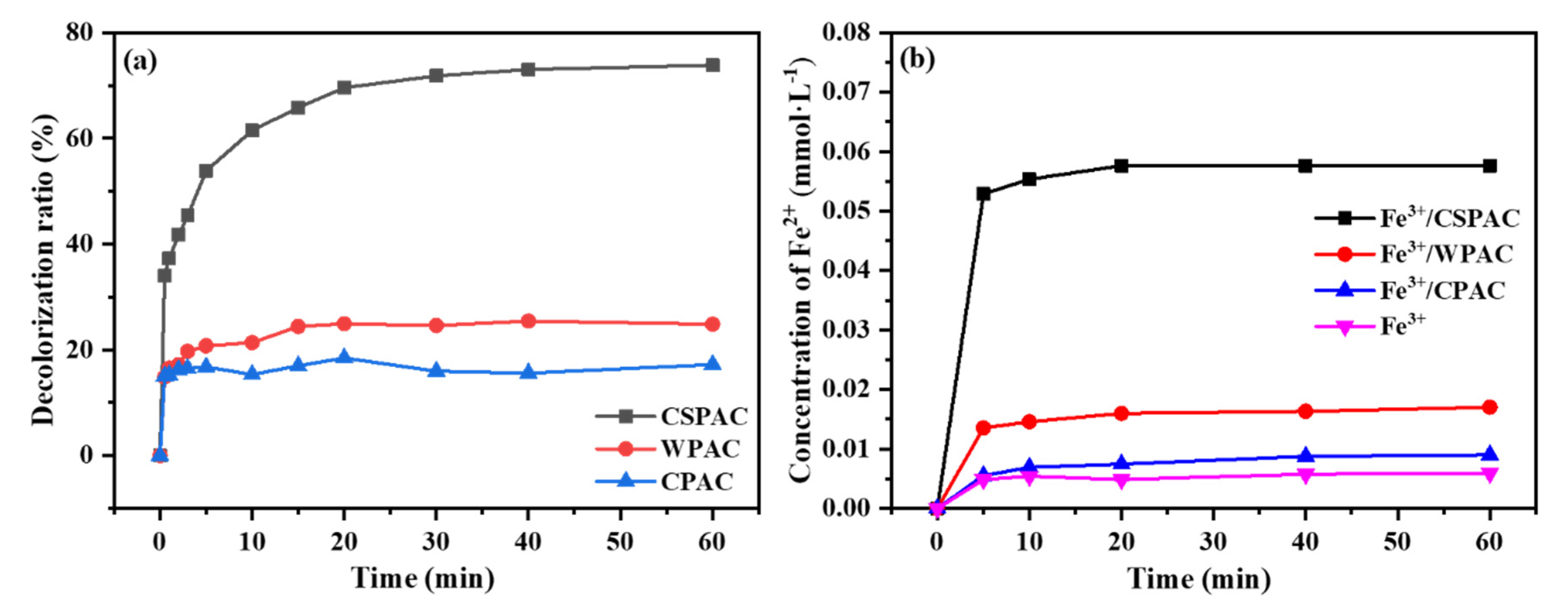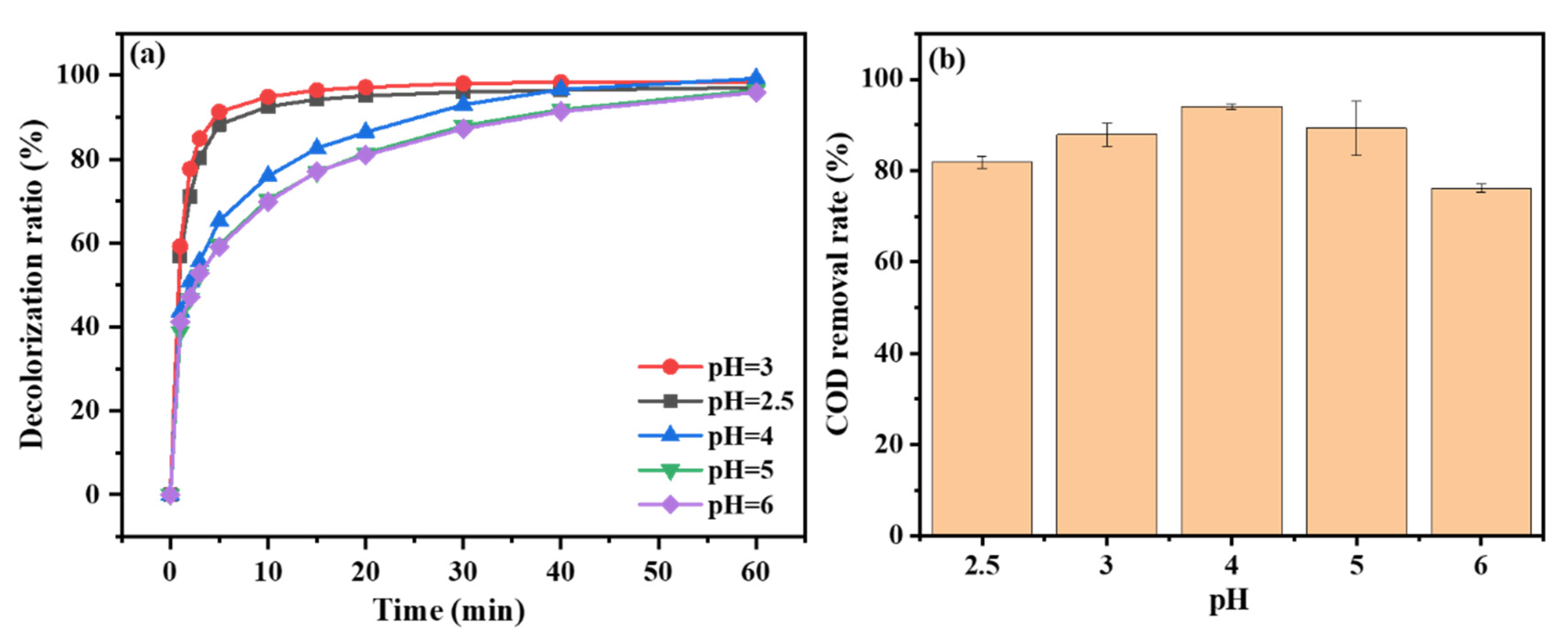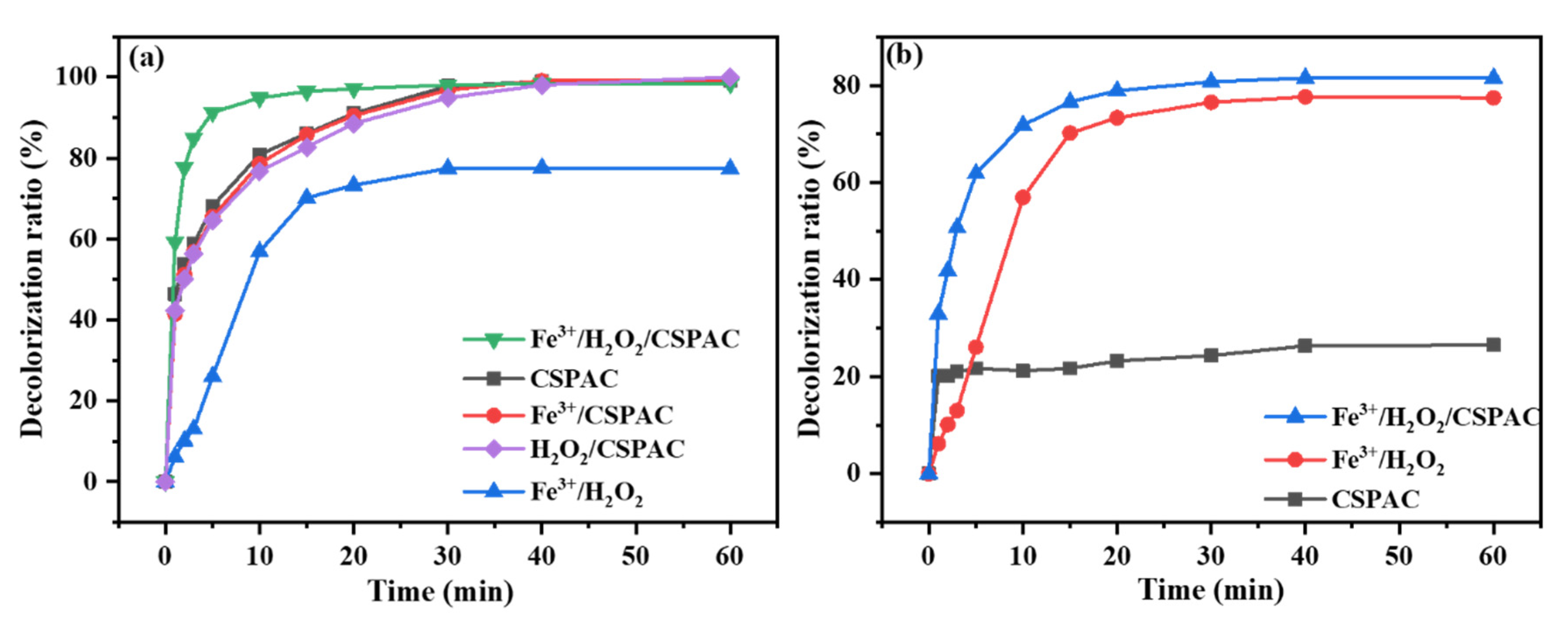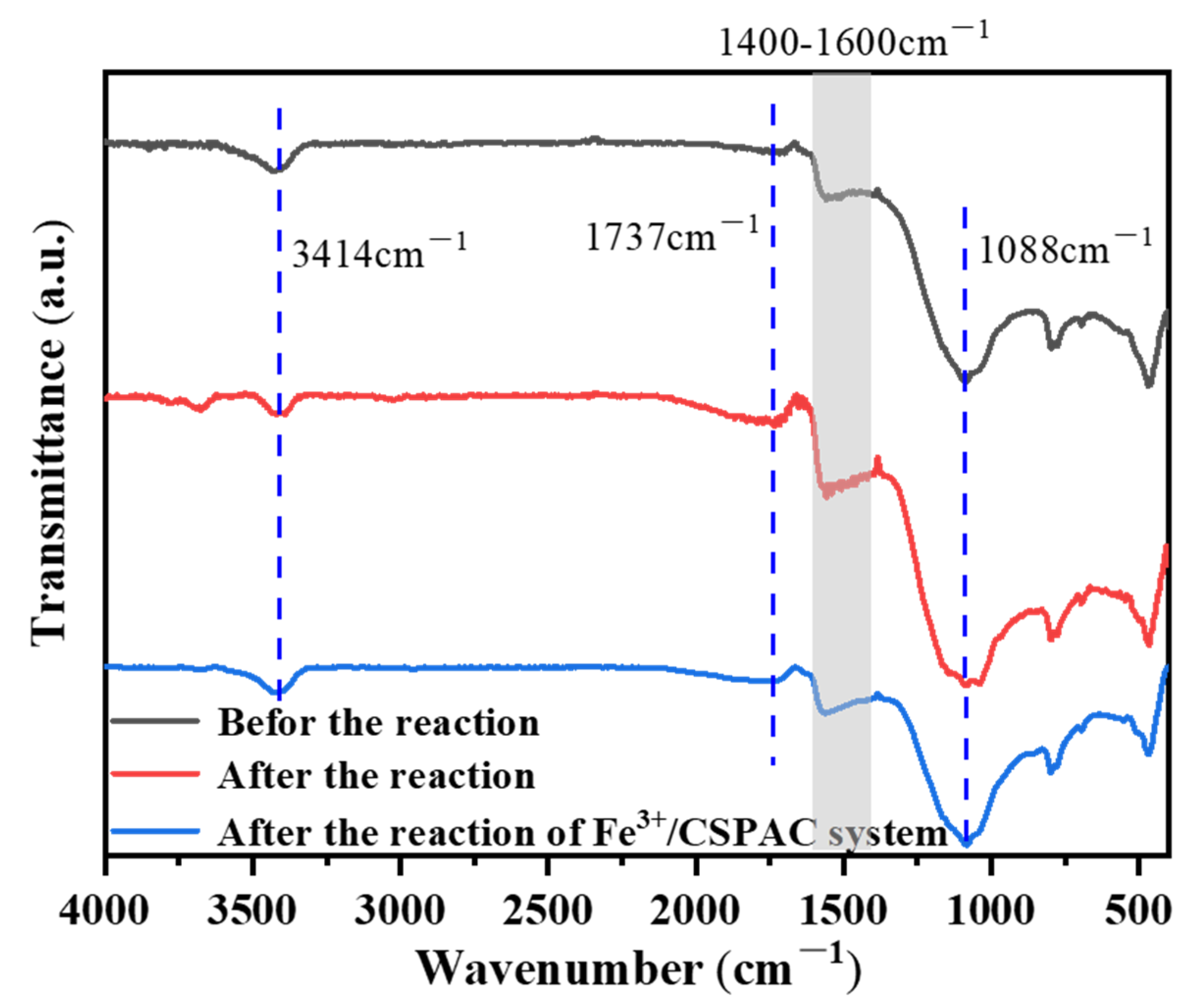Activated Carbon Assisted Fenton-like Treatment of Wastewater Containing Acid Red G
Abstract
:1. Introduction
2. Materials and Methods
2.1. Materials
2.2. Characterization
2.3. Experimental Procedures
2.4. Analytical Methods
3. Results and Discussion
3.1. Promotion of Fenton-Like Reaction by Different Kinds of ACs
3.2. Influencing Factors of Fe3+/H2O2/CSPAC System
3.3. Performance of CSPAC Enhanced Fe3+/H2O2 Oxidation
3.4. The Catalytic Process of CSPAC during the Reaction
4. Conclusions
Supplementary Materials
Author Contributions
Funding
Data Availability Statement
Acknowledgments
Conflicts of Interest
References
- Bello, M.M.; Abdul Raman, A.A.; Asghar, A. A review on approaches for addressing the limitations of Fenton oxidation for recalcitrant wastewater treatment. Process Saf. Environ. Prot. 2019, 126, 119–140. [Google Scholar] [CrossRef]
- Liu, Y.; Zhao, Y.; Wang, J.-L. Fenton/Fenton-like processes with in-situ production of hydrogen peroxide/hydroxyl radical for degradation of emerging contaminants: Advances and prospects. J. Hazard. Mater. 2021, 404, 124191. [Google Scholar] [CrossRef] [PubMed]
- Yang, H.-H.; Shi, B.-F.; Wang, S.-L. Fe Oxides Loaded on Carbon Cloth by Hydrothermal Process as an Effective and Reusable Heterogenous Fenton Catalyst. Catalysts 2018, 8, 207. [Google Scholar] [CrossRef] [Green Version]
- Partido, E.; Dominguez, J.R.; Torregrosa, J.; de Heredia, J.B. Degradation of wine distillery wastewaters by the combination of aerobic biological treatment with chemical oxidation by Fenton’s reagent. Water Sci. Technol. 2005, 51, 167–174. [Google Scholar]
- Hakika, D.C.; Sarto, S.; Mindaryani, A.; Hidayat, M. Decreasing COD in Sugarcane Vinasse Using the Fenton Reaction: The Effect of Processing Parameters. Catalysts 2019, 9, 881. [Google Scholar] [CrossRef] [Green Version]
- Tang, J.-T.; Wang, J.-L. Fenton-like degradation of sulfamethoxazole using Fe-based magnetic nanoparticles embedded into mesoporous carbon hybrid as an efficient catalyst. Chem. Eng. J. 2018, 351, 1085–1094. [Google Scholar] [CrossRef]
- Liu, X.-Y.; Zhang, Q.; Yu, B.-W.; Wu, R.-H.; Mai, J.-X.; Wang, R.-J.; Chen, L.-Y.; Yang, S.-T. Preparation of Fe3O4/TiO2/C Nanocomposites and Their Application in Fenton-Like Catalysis for Dye Decoloration. Catalysts 2016, 6, 146. [Google Scholar] [CrossRef] [Green Version]
- Liu, X.-H.; Xie, L.-B.; Liu, Y.-G.; Zhao, P.; Han, Y.-G.; Cheng, S.-S.; Bai, X.-Y.; Li, Y. Rapid preparation of highly stable ZnO-CeO2/CF cathode by one-step electro-deposition for efficient degradation of ciprofloxacin in electro-Fenton system. Catal. Today 2020, 355, 458–465. [Google Scholar] [CrossRef]
- Wang, J.; Zhou, X.; Gatheru Waigi, M.; Owino Gudda, F.; Cheng, P.; Ling, W. Simultaneous Removal of Estrogens and Antibiotics from Livestock Manure Using Fenton Oxidation Technique. Catalysts 2019, 9, 644. [Google Scholar] [CrossRef] [Green Version]
- Liu, X.-C.; Zhou, Y.-Y.; Zhang, J.-C.; Luo, L.; Yang, Y.; Huang, H.-L.; Peng, H.; Tang, L.; Mu, Y. Insight into electro-Fenton and photo-Fenton for the degradation of antibiotics: Mechanism study and research gaps. Chem. Eng. J. 2018, 347, 379–397. [Google Scholar] [CrossRef]
- Gharaee, A.; Khosravi-Nikou, M.R.; Anvaripour, B. Hydrocarbon contaminated soil remediation: A comparison between Fenton, sono-Fenton, photo-Fenton and sono-photo-Fenton processes. J. Ind. Eng. Chem. 2019, 79, 181–193. [Google Scholar] [CrossRef]
- Yu, G.-H.; Kuzyakov, Y. Fenton chemistry and reactive oxygen species in soil: Abiotic mechanisms of biotic processes, controls and consequences for carbon and nutrient cycling. Earth Sci. Rev. 2021, 214, 103525. [Google Scholar] [CrossRef]
- Checa-Fernandez, A.; Santos, A.; Romero, A.; Dominguez, C.M. Application of Chelating Agents to Enhance Fenton Process in Soil Remediation: A Review. Catalysts 2021, 11, 722. [Google Scholar] [CrossRef]
- Tang, Z.-M.; Zhao, P.-R.; Wang, H.; Liu, Y.-Y.; Bu, W.-B. Biomedicine Meets Fenton Chemistry. Chem. Rev. 2021, 121, 1981–2019. [Google Scholar] [CrossRef]
- Wei, S.-B.; Qiao, Y.-Q.; Wu, Z.-C.; Liu, X.-M.; Li, Y.; Cui, Z.-D.; Li, C.-Y.; Zheng, Y.-F.; Liang, Y.-Q.; Li, Z.-Y.; et al. Na+ inserted metal-organic framework for rapid therapy of bacteria-infected osteomyelitis through microwave strengthened Fenton reaction and thermal effects. Nano Today 2021, 37, 101090. [Google Scholar] [CrossRef]
- Neyens, E.; Baeyens, J. A review of classic Fenton’s peroxidation as an advanced oxidation technique. J. Hazard. Mater. 2003, 98, 33–50. [Google Scholar] [CrossRef]
- Zhang, M.-H.; Dong, H.; Zhao, L.; Wang, D.-X.; Meng, D. A review on Fenton process for organic wastewater treatment based on optimization perspective. Sci. Total Environ. 2019, 670, 110–121. [Google Scholar] [CrossRef]
- Pignatello, J.J.; Oliveros, E.; MacKay, A. Advanced Oxidation Processes for Organic Contaminant Destruction Based on the Fenton Reaction and Related Chemistry. Crit. Rev. Environ. Sci. Technol. 2006, 36, 1–84. [Google Scholar] [CrossRef]
- Lee, C.; Sedlak, D.L. A Novel Homogeneous Fenton-like System with Fe(III)-Phosphotungstate for Oxidation of Organic Compounds at Neutral pH Values. J. Mol. Catal. A Chem. 2009, 311, 1–6. [Google Scholar] [CrossRef] [Green Version]
- Xu, T.-Y.; Zhu, R.-L.; Zhu, G.-Q.; Zhu, J.-X.; Liang, X.-L.; Zhu, Y.-P.; He, H.-P. Mechanisms for the enhanced photo-Fenton activity of ferrihydrite modified with BiVO 4 at neutral pH. Appl. Catal. B. 2017, 212, 50–58. [Google Scholar] [CrossRef]
- Kwan, W.P.; Voelker, B.M. Decomposition of hydrogen peroxide and organic compounds in the presence of dissolved iron and ferrihydrite. Environ. Sci. Technol. 2002, 36, 1467–1476. [Google Scholar] [CrossRef] [PubMed]
- Zhu, Y.-P.; Zhu, R.-L.; Xi, Y.-F.; Zhu, J.-X.; Zhu, G.-Q.; He, H.-P. Strategies for enhancing the heterogeneous Fenton catalytic reactivity: A review. Appl. Catal. B. 2019, 255, 117739. [Google Scholar] [CrossRef]
- Hartmann, M.; Kullmann, S.; Keller, H. Wastewater treatment with heterogeneous Fenton-type catalysts based on porous materials. J. Mater. Chem. 2010, 20, 9002–9017. [Google Scholar] [CrossRef]
- Bokare, A.D.; Choi, W. Review of iron-free Fenton-like systems for activating H2O2 in advanced oxidation processes. J. Hazard. Mater. 2014, 275, 121–135. [Google Scholar] [CrossRef] [PubMed]
- Yang, Z.-C.; Yu, A.-Q.; Shan, C.; Gao, G.-D.; Pan, B.-C. Enhanced Fe(III)-mediated Fenton oxidation of atrazine in the presence of functionalized multi-walled carbon nanotubes. Water Res. 2018, 137, 37–46. [Google Scholar] [CrossRef] [PubMed]
- Bolobajev, J.; Kattel, E.; Viisimaa, M.; Goi, A.; Trapido, M.; Tenno, T.; Dulova, N. Reuse of ferric sludge as an iron source for the Fenton-based process in wastewater treatment. Chem. Eng. J. 2014, 255, 8–13. [Google Scholar] [CrossRef]
- Ganiyu, S.O.; Zhou, M.; Martínez-Huitle, C.A. Heterogeneous electro-Fenton and photoelectro-Fenton processes: A critical review of fundamental principles and application for water/wastewater treatment. Appl. Catal. B. 2018, 235, 103–129. [Google Scholar] [CrossRef]
- Clarizia, L.; Russo, D.; Di Somma, I.; Marotta, R.; Andreozzi, R. Homogeneous photo-Fenton processes at near neutral pH: A review. Appl. Catal. B. 2017, 209, 358–371. [Google Scholar] [CrossRef]
- Thor, S.-H.; Ho, L.-N.; Ong, S.-A.; Abidin, C.Z.A.; Heah, C.-Y.; Ong, Y.-P.; Yap, K.-L. A sustainable photocatalytic fuel cell integrated photo-electro-Fenton hybrid system using KOH activated carbon felt cathodes for enhanced Amaranth degradation and electricity generation. Sep. Purif. Technol. 2022, 292, 121041. [Google Scholar] [CrossRef]
- Wang, Y.; Wang, R.-T.; Lin, N.-P.; Xu, J.-C.; Liu, X.-C.; Liu, N.; Zhang, X. Degradation of norfloxacin by MOF-derived lamellar carbon nanocomposites based on microwave-driven Fenton reaction: Improved Fe(III)/Fe(II) cycle. Chemosphere 2022, 293, 133614. [Google Scholar] [CrossRef]
- Monteil, H.; Péchaud, Y.; Oturan, N.; Oturan, M.A. A review on efficiency and cost effectiveness of electro- and bio-electro-Fenton processes: Application to the treatment of pharmaceutical pollutants in water. Chem. Eng. J. 2019, 376, 119577. [Google Scholar] [CrossRef]
- Brillas, E.; Garcia-Segura, S. Benchmarking recent advances and innovative technology approaches of Fenton, photo-Fenton, electro-Fenton, and related processes: A review on the relevance of phenol as model molecule. Sep. Purif. Technol. 2020, 237, 116337. [Google Scholar] [CrossRef]
- Yang, T.-Y.; Yu, D.-Y.; Wang, D.; Yang, T.; Li, Z.-X.; Wu, M.-H.; Petru, M.; Crittenden, J. Accelerating Fe(Ⅲ)/Fe(Ⅱ) cycle via Fe(Ⅱ) substitution for enhancing Fenton-like performance of Fe-MOFs. Appl. Catal. B. 2021, 286, 119859. [Google Scholar] [CrossRef]
- Cheng, M.; Lai, C.; Liu, Y.; Zeng, G.-M.; Huang, D.-L.; Zhang, C.; Qin, L.; Hu, L.; Zhou, C.-Y.; Xiong, W.-P. Metal-organic frameworks for highly efficient heterogeneous Fenton-like catalysis. Coord. Chem. Rev. 2018, 368, 80–92. [Google Scholar] [CrossRef]
- Su, S.-S.; Liu, Y.-Y.; Liu, X.-M.; Jin, W.; Zhao, Y.-P. Transformation pathway and degradation mechanism of methylene blue through beta-FeOOH@GO catalyzed photo-Fenton-like system. Chemosphere 2019, 218, 83–92. [Google Scholar] [CrossRef]
- Wang, T.; Yang, C.C.; Qin, K.; Chen, C.W.; Dong, C.D. Life time enhanced Fenton-like catalyst by dispersing iron oxides in activated carbon: Preparation and reactivation through carbothermal reaction. J. Hazard. Mater. 2021, 406, 124791. [Google Scholar] [CrossRef]
- Wang, C.-Q.; Sun, R.-R.; Huang, R. Highly dispersed iron-doped biochar derived from sawdust for Fenton-like degradation of toxic dyes. J. Clean. Prod. 2021, 297, 126681. [Google Scholar] [CrossRef]
- Zou, C.-Y.; Meng, Z.-D.; Ji, W.-C.; Liu, S.-Q.; Shen, Z.; Zhang, Y.; Jiang, N.-S. Preparation of a fullerene [60]-iron oxide complex for the photo-fenton degradation of organic contaminants under visible-light irradiation. Chin. J. Catal. 2018, 39, 1051–1059. [Google Scholar] [CrossRef]
- Lin, J.-K.; Tian, W.-J.; Guan, Z.-Y.; Zhang, H.-Y.; Duan, X.-G.; Wang, H.; Sun, H.-Q.; Fang, Y.-F.; Huang, Y.-P.; Wang, S.-B. Functional Carbon Nitride Materials in Photo-Fenton-Like Catalysis for Environmental Remediation. Adv. Funct. Mater. 2022, 32, 2201743. [Google Scholar] [CrossRef]
- Peng, L.-J.; Duan, X.-G.; Shang, Y.-N.; Gao, B.-Y.; Xu, X. Engineered carbon supported single iron atom sites and iron clusters from Fe-rich Enteromorpha for Fenton-like reactions via nonradical pathways. Appl. Catal. B. 2021, 287, 119963. [Google Scholar] [CrossRef]
- Wang, C.; Yu, G.-C.; Chen, H.; Wang, J.-L. Degradation of norfloxacin by hydroxylamine enhanced fenton system: Kinetics, mechanism and degradation pathway. Chemosphere 2020, 270, 129408. [Google Scholar] [CrossRef] [PubMed]
- Duesterberg, C.K.; Waite, T.D. Kinetic modeling of the oxidation of p-hydroxybenzoic acid by Fenton’s reagent: Implications of the role of quinones in the redox cycling of iron. Environ. Sci. Technol. 2007, 41, 4103–4110. [Google Scholar] [CrossRef] [PubMed]
- Qin, Y.-X.; Song, F.-H.; Ai, Z.-H.; Zhang, P.-P.; Zhang, L.-Z. Protocatechuic Acid Promoted Alachlor Degradation in Fe(III)/H2O2 Fenton System. Environ. Sci. Technol. 2015, 49, 7948–7956. [Google Scholar] [CrossRef]
- Zhou, P.; Ren, W.; Nie, G.; Li, X.-J.; Duan, X.-G.; Zhang, Y.-L.; Wang, S.-B. Fast and Long-Lasting Iron(III) Reduction by Boron Toward Green and Accelerated Fenton Chemistry. Angew. Chem. Int. Ed. Engl. 2020, 59, 16517–16526. [Google Scholar] [CrossRef] [PubMed]
- Fontecha-Cámara, M.A.; Álvarez-Merino, M.A.; Carrasco-Marín, F.; López-Ramón, M.V.; Moreno-Castilla, C. Heterogeneous and homogeneous Fenton processes using activated carbon for the removal of the herbicide amitrole from water. Appl. Catal. B. 2011, 101, 425–430. [Google Scholar] [CrossRef]
- Dogan, E.C.; Kilicoglu, O.; Narci, A.O.; Mert, B.K.; Durna, E.; Akbacak, U.A.; Aydiner, C. Fenton and photo-Fenton processes integrated with submerged ultrafiltration for the treatment of pulp and paper industry wastewater. J. Environ. Chem. Eng. 2021, 9, 105878. [Google Scholar] [CrossRef]
- Lv, H.-L.; Zhao, H.-Y.; Cao, T.-C.; Qian, L.; Wang, Y.-B.; Zhao, G. Efficient degradation of high concentration azo-dye wastewater by heterogeneous Fenton process with iron-based metal-organic framework. J. Mol. Catal. A Chem. 2015, 400, 81–89. [Google Scholar] [CrossRef]
- Tian, Y.-S.; Fu, W.-Y.; Wang, Q.; Tang, Y.-P.; Zhou, M. High electron transfer rate and efficiency on Fe0 modified by sulfidation and pre-magnetization for carbamazepine degradation by heterogeneous electro-Fenton in wide pH ranges. Chem. Eng. J. 2022, 427, 131694. [Google Scholar] [CrossRef]
- Chen, L.-W.; Ma, J.; Li, X.-C.; Zhang, J.; Fang, J.-Y.; Guan, Y.-H.; Xie, P.-C. Strong Enhancement on Fenton Oxidation by Addition of Hydroxylamine to Accelerate the Ferric and Ferrous Iron Cycles. Environ. Sci. Technol. 2011, 45, 3925–3930. [Google Scholar] [CrossRef]
- Li, T.; Zhao, Z.-W.; Wang, Q.; Xie, P.-F.; Ma, J.-H. Strongly enhanced Fenton degradation of organic pollutants by cysteine: An aliphatic amino acid accelerator outweighs hydroquinone analogues. Water Res. 2016, 105, 479–486. [Google Scholar] [CrossRef]
- Ren, H.-J.; Jin, X.; Li, C.-G.; Li, T.-T.; Liu, Y.; Zhou, R. Rosmarinic acid enhanced Fe(III)-mediated Fenton oxidation removal of organic pollutants at near neutral pH. Sci. Total Environ. 2020, 736, 139528. [Google Scholar] [CrossRef] [PubMed]
- Navalon, S.; Dhakshinamoorthy, A.; Alvaro, M.; Garcia, H. Heterogeneous fenton catalysts based on activated carbon and related materials. ChemSusChem 2011, 4, 1712–1730. [Google Scholar] [CrossRef] [PubMed]
- Wang, H.-Z.; Guo, W.-Q.; Yin, R.-L.; Du, J.-S.; Wu, Q.-L.; Luo, H.-C.; Liu, B.-H.; Sseguya, F.; Ren, N. Biochar-induced Fe(III) reduction for persulfate activation in sulfamethoxazole degradation: Insight into the electron transfer, radical oxidation and degradation pathways. Chem. Eng. J. 2019, 362, 561–569. [Google Scholar] [CrossRef]
- Zhou, L.; Liu, Y.-G.; Liu, S.-B.; Yin, Y.-C.; Zeng, G.-M.; Tan, X.-F.; Hu, X.; Hu, X.-J.; Jiang, L.-H.; Ding, Y.; et al. Investigation of the adsorption-reduction mechanisms of hexavalent chromium by ramie biochars of different pyrolytic temperatures. Bioresour. Technol. 2016, 218, 351–359. [Google Scholar] [CrossRef]
- Seo, J.; Lee, H.-J.; Lee, H.; Kim, H.-E.; Lee, J.-Y.; Kim, H.S.; Lee, C. Enhanced production of reactive oxidants by Fenton-like reactions in the presence of carbon materials. Chem. Eng. J. 2015, 273, 502–508. [Google Scholar] [CrossRef]
- Shi, B.-F.; Zhao, C.-C.; Ji, Y.-J.; Shi, J.-W.; Yang, H.-H. Promotion effect of PANI on Fe-PANI/Zeolite as an active and recyclable Fenton-like catalyst under near-neutral condition. Appl. Surf. Sci. 2020, 508, 145298. [Google Scholar] [CrossRef]
- Harvey, A.E.; Smart, J.A.; Amis, E.S. Simultaneous Spectrophotometric Determination of Iron(II) and Total Iron with 1,10-Phenanthroline. Anal. Chem. 2002, 27, 26–29. [Google Scholar] [CrossRef]
- Qiao, D.; Xu, Z.-C.; Guo, H.; Wang, X.; Wan, D.; Li, X.-Y.; Xu, H.; Yan, W. Non-traditional power supply mode: Investigation of electrodeposition towards a better understanding of PbO2 electrode for electrochemical wastewater treatment. Mater. Chem. Phys. 2022, 284, 126066. [Google Scholar] [CrossRef]
- Bello, M.M.; Raman, A.A.A.; Asghar, A. Activated carbon as carrier in fluidized bed reactor for Fenton oxidation of recalcitrant dye: Oxidation-adsorption synergy and surface interaction. J. Water Process Eng. 2020, 33, 101001. [Google Scholar] [CrossRef]
- Shen, L.; Wang, W.; Li, T.; Cui, Y.-Z.; Wang, B.; Yu, G.; Wang, X.-H.; Wei, D.; Xiao, J.-Z.; Deng, S.-B. Powdered activated coke for COD removal in the advanced treatment of mixed chemical wastewaters and regeneration by Fenton oxidation. Chem. Eng. J. 2019, 371, 631–638. [Google Scholar] [CrossRef]
- Mendez, A.; Tarquis, A.M.; Saa-Requejo, A.; Guerrero, F.; Gasco, G. Influence of pyrolysis temperature on composted sewage sludge biochar priming effect in a loamy soil. Chemosphere 2013, 93, 668–676. [Google Scholar] [CrossRef] [PubMed]
- Liu, X.-L.; Yin, H.-L.; Lin, A.-L.; Guo, Z.-Q. Effective removal of phenol by using activated carbon supported iron prepared under microwave irradiation as a reusable heterogeneous Fenton-like catalyst. J. Environ. Chem. Eng. 2017, 5, 870–876. [Google Scholar] [CrossRef]
- Shin, S.; Jang, J.; Yoon, S.H.; Mochida, I. A study on the effect of heat treatment on functional groups of pitch based activated carbon fiber using FTIR. Carbon 1997, 35, 1739–1743. [Google Scholar] [CrossRef]
- Zhao, W.-K.; Zhou, B. Assessing the role of CNTs in H2O2/Fe(III) Fenton-like process: Mechanism, DFT calculations and ecotoxicity evaluation. Sep. Purif. Technol. 2021, 259, 118218. [Google Scholar] [CrossRef]
- Li, N.; Zhu, J.; Zha, Q.-F. Quantitative and qualitative analyses of oxygen-containing surface function groups on activated carbon. Chem. J. Chin. Univ. 2012, 33, 548–554. [Google Scholar]
- Zhang, Z.-J.; Cui, P.; Chen, X.-Y.; Liu, J.-W. The production of activated carbon from cation exchange resin for high-performance supercapacitor. J. Solid. State Electr. 2013, 17, 1749–1758. [Google Scholar] [CrossRef]













Publisher’s Note: MDPI stays neutral with regard to jurisdictional claims in published maps and institutional affiliations. |
© 2022 by the authors. Licensee MDPI, Basel, Switzerland. This article is an open access article distributed under the terms and conditions of the Creative Commons Attribution (CC BY) license (https://creativecommons.org/licenses/by/4.0/).
Share and Cite
Yan, X.; Li, H.; Feng, J.; Hou, B.; Yan, W.; Zhou, M. Activated Carbon Assisted Fenton-like Treatment of Wastewater Containing Acid Red G. Catalysts 2022, 12, 1358. https://doi.org/10.3390/catal12111358
Yan X, Li H, Feng J, Hou B, Yan W, Zhou M. Activated Carbon Assisted Fenton-like Treatment of Wastewater Containing Acid Red G. Catalysts. 2022; 12(11):1358. https://doi.org/10.3390/catal12111358
Chicago/Turabian StyleYan, Xuanye, Hang Li, Jiangtao Feng, Bo Hou, Wei Yan, and Min Zhou. 2022. "Activated Carbon Assisted Fenton-like Treatment of Wastewater Containing Acid Red G" Catalysts 12, no. 11: 1358. https://doi.org/10.3390/catal12111358
APA StyleYan, X., Li, H., Feng, J., Hou, B., Yan, W., & Zhou, M. (2022). Activated Carbon Assisted Fenton-like Treatment of Wastewater Containing Acid Red G. Catalysts, 12(11), 1358. https://doi.org/10.3390/catal12111358







